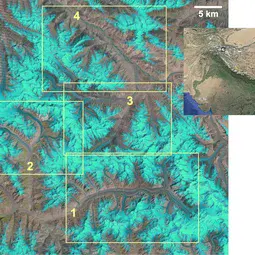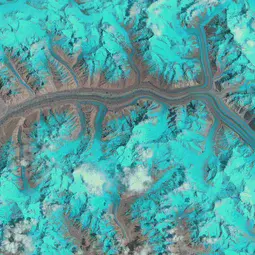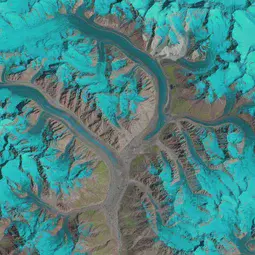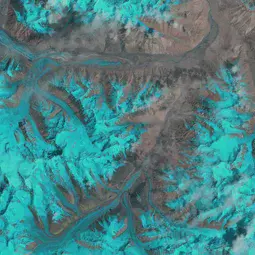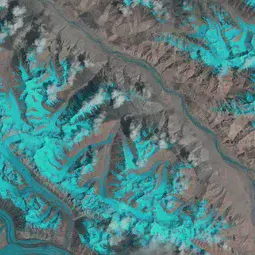Revealing glacier flow with animated satellite images
Frank Paul, a glaciologist at the University of Zurich in Switzerland, has created animations from satellite images of the Karakoram mountain range in Asia to show how its glaciers flow and change. The images of four different regions compress 25 years of glacier changes into just one second, revealing the complex glacier behaviour in the Karakoram. The animations are published today (26 November) in The Cryosphere, an open access journal of the European Geosciences Union (EGU).
The new animations reveal glacier flow and changes over a much longer time period and at a much larger scale than ever before, using the Karakoram as an example. While time-lapse movies made using daily photographs taken with cameras stationed at glacier fronts are available for some glaciers, they only show changes over a few days to a few years and for a small part of a glacier. The animations now created with satellite images provide a whole new look at glacier dynamics.
The animations use images acquired from 1990 to 2015 by three different Landsat satellites, operated by the US Geological Survey (USGS) and NASA. Twenty five years of relatively slow glacier change are compressed into one second, meaning glacier movement is sped up some 800 million times. “The most interesting insight is to really see how the glaciers flow and how the individual parts of the glaciers, such as the tributary streams, interact,” says Paul.
Paul produced the image sequences for four regions – Baltoro, Panmah, Skamri–Sarpo Laggo, and Shaksgam – in the central Karakoram. This mountain range is home to some of the highest peaks in the world, including the famous K2, and glaciers of varying sizes cover much of the steep and high terrain. They show complex behaviour: most of them are not retreating, unlike in other regions in the world, but are advancing or surging (with speeds up to 100 times faster than normal at times) and flowing into each other.
“From a scientific point of view, the key motivation for this research was to understand the highly variable behaviour of the glaciers in the Karakoram. We have known about this for over 50 years, but still have a very limited scientific understanding of what is going on there. The animations are a very practical way to get a better overview and follow the changes through time.”
The time-lapse view makes it easier for the human eye to follow glacier flow and detect changes. The Baltoro animation, for example, highlights how fast and steadily the glacier is flowing without changing the position of its front, while the Panmah image sequence shows several surging glaciers flowing into each other.
These changes would be hard to observe by other methods, such as by comparing side-by-side images of a glacier taken at different times. “The side-by-side comparison is a very tedious thing as the brain cannot freeze-frame and virtually overlay the images,” Paul explains. “This inability is classically played with in the ‘Find the ten errors’ images shown in the game corner of many magazines.”
As detailed in The Cryosphere, Paul created the animations in simple gif format using satellite images freely available for download from the USGS website. For each animated gif, he used 7 to 15 false-colour satellite images, with glaciers shown in light blue to cyan, clouds in white, water in dark blue, vegetation in green and bare terrain in pink to brown. Paul then used free software to create a looping animated gif (showing each frame for 0.1 seconds) for each of the four Karakoram regions.
“I like the idea of applying an ‘old-school’ and very simple file format, along with freely available software, to do something that is difficult to achieve with other formats or commercial software Paul says. The gif image format, which only supports 256 colours, is popular on the Internet, and this study shows it has potential in glaciological research as well.
Paul believes that animated satellite images could also find use as educational tools, helping the wider public understand glacier dynamics. “But most importantly, anybody can create these animations,” he states. “Everything required to do it – both images and software – is freely available, so I recommend trying this at home.”
###
Please mention the name of the publication (The Cryosphere) if reporting on this story and, if reporting online, include a link to the paper (http://www.the-cryosphere.net/9/2201/2015/tc-9-2201-2015.html) or to the journal website (http://www.the-cryosphere.net).
More information
This research is presented in the paper ‘Revealing glacier flow and surge dynamics from animated satellite image sequences: examples from the Karakoram’ to appear in the EGU open access journal The Cryosphere on 26 November 2015.
Citation: Paul, F.: Revealing glacier flow and surge dynamics from animated satellite image sequences: examples from the Karakoram, The Cryosphere, 9, 2201-2214, doi:10.5194/tc-9-2201-2015, 2015.
The study has been performed by Frank Paul (Department of Geography, University of Zurich, Switzerland) and was funded by ESA, the European Space Agency, in the framework of the Climate Change Initiative.
The European Geosciences Union (EGU) is Europe’s premier geosciences union, dedicated to the pursuit of excellence in the Earth, planetary, and space sciences for the benefit of humanity, worldwide. It is a non-profit interdisciplinary learned association of scientists founded in 2002. The EGU has a current portfolio of 17 diverse scientific journals, which use an innovative open access format, and organises a number of topical meetings, and education and outreach activities. Its annual General Assembly is the largest and most prominent European geosciences event, attracting over 11,000 scientists from all over the world. The meeting’s sessions cover a wide range of topics, including volcanology, planetary exploration, the Earth’s internal structure and atmosphere, climate, energy, and resources. The EGU 2016 General Assembly is taking place in Vienna, Austria, from 17 to 22 April 2016. For information about meeting and press registration, please check http://media.egu.eu, or follow the EGU on Twitter and Facebook.
The EGU offers fellowships (up to €5,000) to journalists wishing to report on geoscientific research not yet in the public sphere. The award offers journalists the opportunity to follow geoscientists on location and to develop an in-depth understanding of their research questions, approaches, findings and motivation. Applications for the 2016 fellowships are open until 6 December.
If you wish to receive our press releases via email, please use the Press Release Subscription Form at http://www.egu.eu/news/subscribe/. Subscribed journalists and other members of the media receive EGU press releases under embargo (if applicable) 24 hours in advance of public dissemination.
The Cryosphere (TC) is an international scientific journal dedicated to the publication and discussion of research articles, short communications, and review papers on all aspects of frozen water and ground on Earth and on other planetary bodies. Find out more about the journal on its website or by following The Cryosphere on Twitter.
Contact
Frank Paul
Senior researcher
Department of Geography
University of Zurich
Zurich, Switzerland
Email frank.paul@geo.uzh.ch
Phone +41-44-635 51 75
Bárbara Ferreira
Media and Communications Manager
European Geosciences Union (EGU)
Munich, Germany
Phone +49-89-2180-6703
Email media@egu.eu
EGU on Twitter: @EuroGeosciences
Links
- Scientific paper
- Supplement to the paper, with the four animations
- Satellite images used in the animations
- Journal – The Cryosphere
- Press release on the European Space Agency website
- Read this press release in simplified language, aimed at 7–13 year olds, on our Planet Press site


